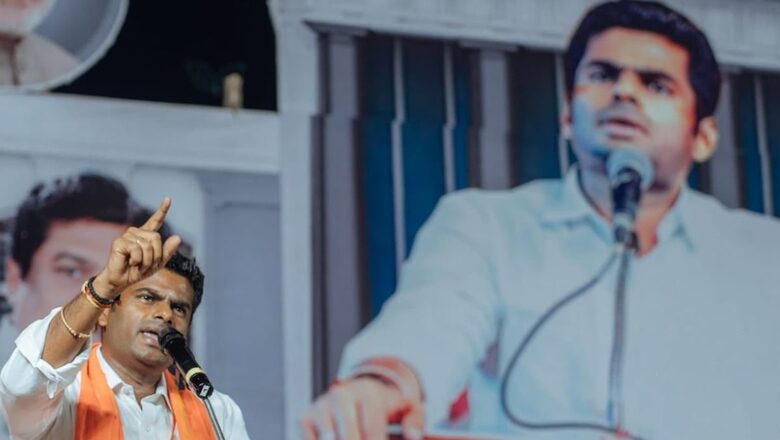
views
It is rather befitting that Tamil Nadu BJP President Annamalai chose Srirangam to launch another salvo against the ruling DMK. Srirangam, the ancient and hoary Vishnu-Kshetra, holds a special civilisational significance. Along with Madurai, it is one of the exemplary sites of the extraordinary Hindu fightback and resurgence that the pioneers of the Vijayanagara Empire ushered in six hundred years ago. It is also an emotional and eternal monument to the memory of Vellayi, a Devadasi who enticed a Turushka iconoclast and jumped to her death so that the deity of Ranganatha could be saved. But if we go by the alleged rationalism of the spurious Dravidian discourse, Vellayi’s heroism too would be bracketed as a Brahminical conspiracy.
Thus, among other things, the presence of E.V. Ramaswamy Naicker’s statue in front of the Ranganathaswamy Temple is an affront to the sacred memory of countless such Vellayis who sought no glory for themselves but gladly died so that Dharma could be preserved.
And Srirangam is not an isolated case. Naicker’s statue has a ubiquitous presence throughout Tamil Nadu, and a majority of them were deliberately erected in the close vicinity of the most sacred temples with the explicit purpose of giving offence to Hindus: what you regard as sacred is fit for annihilation. This is also the one-line summary of the alleged Periyarist-Dravidian ideology.
And so, Annamalai’s promise to remove Naicker’s statue if the BJP comes to power is a baby step towards civilisational rectification. It must not be viewed as an ideological statement but as a socio-cultural imperative that must be accomplished to preserve whatever is left of the innate Hindu character of Tamil culture.
The line invariably accompanying Naicker’s statues reads as follows: “There is no god, there is no god, there is no god at all. He who invented god is a fool. He who propagates god is a scoundrel. He who worships god is a barbarian.” Clearly, this sounds like a rabid atheist’s wet dream. Except that Naicker defines “god” as the deities belonging exclusively to the vast Hindu pantheon of Devatas. The word Deva or Devata is derived from the root, Div which means “light”, where light signifies spiritual wisdom, insight and self-realisation. This selective “Periyarist” definition of god is the reason we don’t see his busts and their attendant inscription outside mosques and churches in Tamil Nadu. It follows a familiar pattern. The unambiguous verdict of the history of Indian public discourse over the last eighty years is this: the atheism and rationalism of Indian intellectuals with Hindu names come to a screeching halt on the marbled steps of a mosque.
Since his debut on the political scene, Annamalai has displayed this civilisational and historical understanding of Dravidianism as the greatest threat to Tamil culture and society. In countless rallies and speeches, he has unwaveringly called out the DMK as an “evil force.”
Let’s not forget the manner in which the Dravidian parties captured power initially. It was not through appeals to the finer sensibilities of the Tamil people. It was not through solemn promises for the betterment of their lives. It was through organised and targeted street violence aimed at uprooting the existing social order and harmony, and the promise of a separate Tamil nation. That they succeeded in this destructive project beyond their wildest dreams is Tamil Nadu’s eternal misfortune.
From this perspective, Annamalai’s uncompromising stand emphasising the intrinsic Sanatana character of Tamil culture is part of repairing the Dravidian damage. A notable instance of this conviction is when he compared the plight of Brahmins in Tamil Nadu to that of the Jews who were persecuted and driven out for two millennia…just for their crime of being born as Jews.
Viewing this complex and historical phenomenon exclusively through political and ideological prisms is ill-informed, misleading and fatal. A fundamental tenet of Sanatana statecraft is that political power is a means to attain a higher end. In the inimitable words of DVG, what is the character and nature of the people of India? What are their life ideals? These are the primary and basic questions that need to be asked in our politics… [in the ideals of our people], the world is just an instrument; the other world is a possibility — it’s something that needs to be attained. A thirsty man needs water. What is required for water is a utensil. Thus, the utensil acquires a value because of water. Likewise, worldly life acquires a value because it enables the attainment of the goal of reaching a higher world. And politics acquires a value because of worldly life. This is the chief principle.
Thus, the dominant narrative in our public discourse which portrays Annamalai’s emphasis on the reclamation of Hindu dharma in Tamil Nadu is a deliberate misdirection. By miscasting his speeches and rallies solely as a bid for political power, this narrative obfuscates the core issue, and there’s simply no other way of saying it: Hindus are an endangered species in Tamil Nadu and the longer the Dravidian ideology persists, the greater is the danger of the state turning into another Kerala or West Bengal.
For all his pretensions to rationality, humanism and equality, E.V. Ramaswamy Naicker and his Dravidian ideology replaced an orderly and functional Tamil society and culture with anti-Hindu hatred, disorder, chaos, separatism and epic corruption. A tiny sample from his 1973 public speech will suffice to illustrate this.
“Wherever we see a temple, we must go inside and break all the idols inside. Wherever we find a Paapaan [pejorative for Tamil Brahmanas], we must kill and destroy him… If one non-Brahmin Tamil dies while trying to kill one Tamil Brahmin, only three of us will die out of every hundred. Ninety-four per cent of us will still remain but Tamil Brahmins will be eliminated. We will definitely go to this level.”
This is the leader in whose honour successive governments and extremist organisations in Tamil Nadu have erected busts…before and adjacent to Hindu temples. Removing them is doing a cultural service to the people of Tamil Nadu.
The author is the founder and chief editor, The Dharma Dispatch. Views expressed in the above piece are personal and solely that of the author. They do not necessarily reflect News18’s views.




















Comments
0 comment